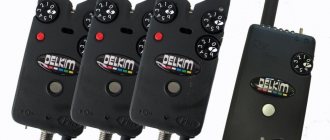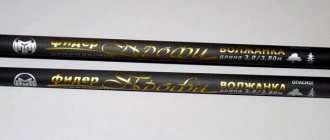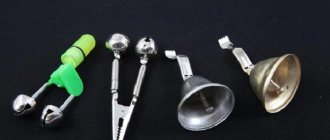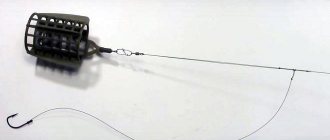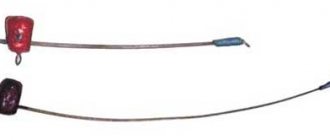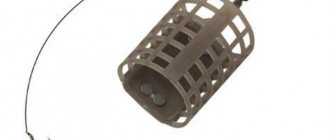The benefits of fishing with a signaling device
Regardless of the variety, all alarms have one task - to respond to fish touching the bait, to notify that a bite has occurred. Among the positive advantages it is worth noting:
- you don’t need to be constantly on guard when fishing on a feeder;
- increasing comfort while fishing;
- ensuring timely cutting;
- the ability to fish with several gears at the same time;
- a wide variety of devices in retail chains.
By using a bite alarm when fishing on a feeder, the angler has more free time. The process takes place in pleasure and regularity. This is an assistant for those who like to hunt trophy specimens such as catfish, bream, carp. If you don’t react in time and miss the moment, then such large individuals will instantly disappear into the thickets along with the hook and bait, damaging the tackle.
To prevent the loss of prey and preserve the equipment, it is worth using a device such as a bite alarm. It will be especially useful when fishing in the dark. As soon as the fish is hooked, he immediately notifies the fisherman sitting by the fire.
Design features
Fishing crucian carp from the water using bottom gear is considered a popular and catchy method. Compared to other methods, it has a number of advantages:
- the use of donks at depths makes it possible to obtain large specimens;
- the equipment can be used in windy weather and during currents, which is not always appropriate with a float fishing rod;
- ease of installation.
Luck will only favor the fisherman if he prepares his equipment correctly.
In many ways, the structure of the donkey is reminiscent of a feeder rig, but the angler receives a signal about the moment of a bite not by the rattling of the rod tip, but by means of a bell.
There is nothing complicated in the design of the donkey. To install the tackle you will need a vein, a sinker and several leashes with hooks tied to them. An important point is to attach the undergrowth to the main thread. If you attach it incorrectly, the leashes will become tangled with each other.
Equipping a donkey requires a combination of many factors. The vein must be used as thin as possible, since crucian carp can see perfectly in the water and avoid suspicious objects, including threads of large diameter.
When catching this fish, it is advisable to use a braided line with a thickness of 0.06-0.12 mm or a monofilament line with a diameter of 0.12-0.27 mm as the main one. The larger the crucian carp in the pond, the more reliable the equipment should be.
To make leashes, thinner material is used, but with good breaking load properties. To prevent the undergrowth from overlapping, the length should not exceed 50 cm.
Donkey tackle must be shipped correctly. The well-chosen shape and weight of this piece of equipment allows the bait to be in the field of view of the fish, and when fishing it does not provide much resistance.
You can choose sinkers of oval, spherical, diamond-shaped, triangular, flat shapes, and their weight depends on the conditions of the reservoir and the strength of the current.
Donk tackle, assembled with your own hands or purchased in a store, must have hooks with the tip bent inward. It is impossible for crucian carp to get rid of such a sting, especially after hooking. The size of the hook depends on the size of the expected prey and the type of bait.
Visual alarms
This type of bite alarm provides control over the tackle through the angler’s visual perception of the clear movements of this device. This category of devices is the most numerous and widespread. It consists of light bite controllers (fireflies, float swingers, side nods), quivertypes for the feeder. The advantages of visual alarms include:
- versatility of use;
- ease of operation;
- compatibility with all types of feeder gear.
These signals are attractive due to their relatively low cost and huge range of products on the fishing market. If you wish, you can make a homemade bite alarm at home. There are even varieties that can be done directly while fishing, near a pond. If you try and modify your homemade device, you can go out hunting at night with it.

To ensure that feeder fishing is not only fun, but also brings a good catch, the bite alarm must meet the following requirements:
- stand out clearly against different backgrounds of nature (in thickets, on the surface of the water);
- do not create difficulties when installing on a stand;
- have an LED inside for better control over the gear;
- be stable in gusts of wind;
- do not interfere with self-regulation of the degree of tension of the fishing line;
- instantly push away the working thread in case of a bite.
When purchasing a visual alarm, you should choose options with the following characteristics:
- built-in additional lighting;
- the possibility of free movement of the swinger lever in the hinge;
- option for instant adjustment of the degree of line tension;
- the presence of a removable installation platform that provides quick connection/disconnection of the indicator;
- the presence of a slow adjustment of the clamping force of the clip;
- The material of the clip must be reliable.
Firefly
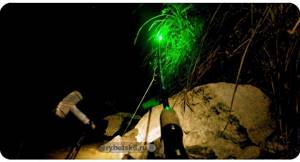
Option for night bite alarm for feeder. The firefly controller works based on the chemical reactions of a pair of substances, when combined, a glow occurs. This effect lasts for 12–20 hours. The compositions are placed in sealed tubes, they are located in separate compartments. For the device to light up, it is enough to squeeze the tube in several places and destroy the partition. When the compositions are mixed, the device begins to fluoresce - glow. The signaling device is supplied with a soft polymer tube for fixing it to the quiver tip of the tackle.
A firefly is mounted at the end of the feeder; its movements determine the degree of interest of the fish in the proposed bait. You can attach the device to the end of the rod not only with a soft tube, but also with electrical tape, adhesive tape, or regular tape. The high effectiveness of using a firefly is observed when it is combined with bells and other sound alarms on the feeder. This is especially effective when fishing with several rods at once. At night, when a fish bites the bait, the bell will loudly signal, and the luminous element will indicate a specific tackle.
The firefly belongs to the group of disposable devices, but if you place it in the freezer after fishing, you can extend its service life. The chemical reactions inside the tube will stop, and the device can be used again at another exit.
Pendulum

The pendulum bite alarm is made of a wire rod, at the ends of which there are loops located at right angles to it. At one end of the controller there is a spherical weight-tip. Many devices have a hole for attaching a firefly.
The pendulum alarm is suspended on a thread, leading it through the holes in the wire loops onto the fishing line of the fishing rod. It is installed between the coil and the first pass ring. In a calm position, the tip provides sagging of the thread; when the moment of bite occurs, it is tensioned, and the sagging eliminates itself. This is the signal to make the cut.
The negative aspects of using a pendulum signaling device include:
- poor visibility of bites towards the shore;
- feeling of discomfort when casting gear;
- frequent hits on the form.
Quivertip
Fans of feeder fishing often use the quivertip itself as a bite controller. Based on its deviations from the given position, the appropriate moment for cutting is determined.

If the angler does not yet have the proper experience or the tip of the tackle is not highly sensitive, it is better to use an auxiliary element - a side nod.
Side warning light
You can make a side bite alarm at home from elastic metal wire; a plate 20 cm long is also suitable. The device is mounted on the rod between the handle and the first guide ring (the largest diameter). A thick rubber ring with a diameter larger than the form at the place of fixation will be used as fastening.
For greater effectiveness, the bite alarm should be made in a bright color or equipped with colored cambrics. Thanks to this simple technique, it can be observed over 10 m from the shore. Side alarms are highly sensitive devices; they instantly respond to any line tension. In this case, missing a hook is unlikely.
Loading …
Homemade firefly for feeder
You can make a homemade bite alarm for the feeder that will glow at night. To do this you need:
- A plastic tube 5-7 cm long (can be used for polyurethane foam).
- White LED. It needs to be inserted into the tube and secured with glue.
- 3V battery. Place it in the heat shrink tube to ensure a seal.
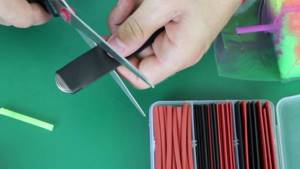
Connect the LED to the battery; you can use hot glue for insulation. You can attach the alarm to the tip of the rod using adhesive tape.
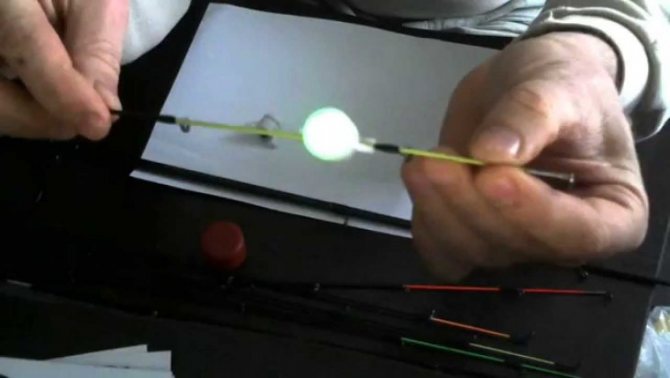
There are ready-made battery-powered fireflies on sale that begin to glow when the tension of the fishing line changes. They are more effective because they signal directly when a bite occurs.
Sound alarms
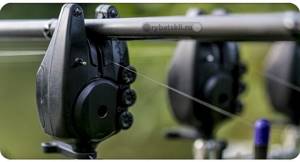
A universal model that can be used both day and night. Very often, sound devices can be found in combination with luminous bite indicators. This group may include both mechanical and electronic devices. The first group includes bells and bells, and the second category includes devices that use batteries/sound buzzers to sound.
An undeniable advantage of sound devices is the ability to send a signal over long distances. The only disadvantage is reduced efficiency when fishing in strong wind conditions. That is, there are false alarms of the controller.
The most primitive version of a sound bite alarm is a product made from a pair of hollow tubes. The main thing here is that when two elements touch, a characteristic noise is created. The tubes are tied with a thread at the ends and thrown over a cord. At the moment the tension of the working line changes, the tubes touch each other and notify the angler that a fish has been hooked.
Bell
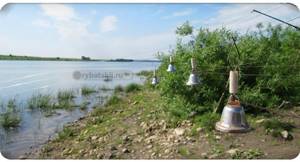
This is a classic version of an audible alarm. It is presented in the form of an ordinary miniature bell made of copper/brass. The bell is installed on the cord between the first pass ring and the coil through the use of special clamps. You can also use fragments of rubber with slots here.
To simplify the task when disconnecting the bell while reeling in the cord and fishing the prey ashore, you can additionally secure it with a piece of fishing line to the stand. You can also attach the bell to a peg driven into the ground.
Expert opinion
Anton Timoshin
Feeder fishing expert
Ask a Question
I believe that in classic feeder fishing, bite alarms are not needed, except for the quivertip itself. Even when fishing at night, you can get by with a good flashlight. I would use bite alarms when catching burbot and catfish on donkeys.
Expert answers to questions
What if you are fishing on two feeders at the same time?
Similarly, we determine the bite by the quivertype of the feeder
If a beginner doubts the correctness of bite detection, should he start with a bell, for example?
Absolutely not. It is not right. It’s better to learn how to fish correctly with a feeder right away.
Bells
Bells are closed-type signaling devices; they consist of 2–3 spherical hollow bodies. They have slots for sound, which is produced as a result of movement inside the balls. In most cases, such bite indicators are mounted on a rod stand. It is unwise to attach them to the feeder without any support. It's not practical. If you fix the bells to the top of the rod, it will be overloaded, which is not desirable.
To ensure free movement of the bite indicator, the bells should be mounted on a stand with a small gap. This will ensure the clarity of the transmission of their vibrations.
Electronic signaling devices
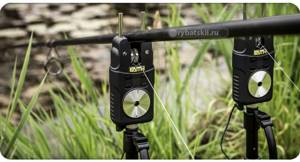
An electronic bite alarm for a feeder is often used by carp anglers. Their operating principle is based on placing the feeder line into the impeller, which closes the contacts when turned. Here, mechanical energy is converted into electrical energy, which is transmitted to the LEDs and audible buzzer of the device. Thus, a signal is obtained. The controller uses rechargeable batteries/disposable batteries to operate.
The advantages of electronic devices include:
- full automation of the bite process;
- clear signal transmission over long distances;
- increased sensitivity;
- eliminating false positives;
- cutting off fishing line vibrations caused by waves, gusts of wind, and currents;
- the ability to quickly identify the rod that worked.
Disadvantages:
- high price;
- you need to have basic and spare batteries;
- the need for additional equipment (pod, several rigid racks).
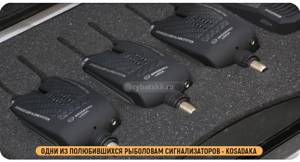
Among the popular electronic models, it is worth highlighting:
- DelkimTx-i Plus. Reliable and versatile.
- RXNX-R Series (Fox International). This model is distinguished by its ability to work at a distance of 200 meters away from the shore. The set contains 3–4 such controllers.
- Kosadaka. The alarms were appreciated by both novice feeders and experienced fishermen.
- BarracudaT5. You can customize it for yourself by adjusting the volume, light notification, and degree of sensitivity to bites. Due to the rubberized casing, this device can be used even in adverse weather conditions. In addition, it is also waterproof.
- Winner. The model has both light indication and sound. Its sensitivity is at a high level, the body is not afraid of moisture. For ease of use, the manufacturer has made touch buttons (on/off). Both volume and light tone can be adjusted. The duration of the light warning is 20 seconds.
- FOX. The device has 4 LEDs and night lighting. There are different light signals, by which you can determine whether the prey is moving deeper into the reservoir, or is approaching the shore with bait.
Homemade bite alarm for feeder
Making a bite alarm at home is easy, just prepare the necessary materials and tools and adhere to a certain technology.
Option 1

To make a bite controller you will need:
- flexible wire material with a diameter of 2 mm;
- stoppers from plastic containers (2–3 pieces);
- pliers;
- wire cutters
The algorithm for performing the work is as follows:
- Prepare a piece of wire 25 cm long.
- Bend with pliers, on one side, at three points.
- Heat the end of the workpiece and make holes in the plastic bottle caps in the center.
- Place the plugs on the wire, moving them closer to the bend.
- Bend the other end at a right angle for mounting to the rack.
The device must be movable; it can be done through a hole in the rack or by using a bracket. A primitive fastening option consists of two plugs with holes, which are connected to each other using electrical tape. They can be mounted on a rack using the same electrical tape.
Option 2

Instructions for making a feeder alarm:
- Select a blank tube; its diameter should be slightly larger than the first throughput ring, which is near the coil.
- Wrap aluminum foil around the workpiece in 3-4 layers.
- Secure with tape.
- Cut it so that you get a tube 10–15 cm long.
- When the tackle is assembled, pass the working thread through the tube between the reel and the large winding ring.
- After casting the tackle, the aluminum foil alarm will take its working position, creating a slack in the fishing line. If necessary, the device can be made heavier.
Side bite alarm for feeder
Mechanism of operation
The side signaling device is presented in the form of a nod manufacturing design. The similarity lies in the presence of a spring, which forms its basis. It is also attached to the feeder form. A distinctive feature is the placement of the device between the primary feeder ring and the coil.
Its length is determined to be 15 cm. The part of the feeder located on the opposite side is equipped with a hook, on which the fishing line is laid after casting. When installing the alarm, the angle of location should be 90 degrees. If there is a bite, then the fishing line is pulled and thus the alarm is placed parallel to the feeder.
How it is made
To make it, you will need a tube made of metal material, the length of which should be up to 5 cm, and the diameter should be 2-3 mm. The signaling device is mounted on the feeder form, taking into account a distance of up to 15 cm from the coil. Next, take a spring, the length of which should reach 20 cm.
Next, at one end you need to bend the spring 90 degrees to secure it to the tube. The second end is brought into the shape of a hook, taking into account the length of the bends up to 1 cm. After the installation is completed, the fishing line is pulled out and inserted onto the hook of the alarm.
Important: It is necessary to ensure that the alarm is made of less rigid material. With hard material, the sensitivity of the detector decreases.
How to install a bite alarm on a feeder
For feeder hunting to be successful, you need to properly attach the bite controller.
Installation of an electronic alarm
It is convenient to use the rod-pod system to place gear. It is better to install bite indicators on a stand using a threaded connection. The working thread must be passed through the roller of the electronic device. If the reel is equipped with a baitrunner, then the clutch should be released.
The device is configured using specific buttons, adjusting the tone and volume of the alert, and the degree of sensitivity of the device to bites. The length of the brace will depend on gusts of wind, its direction, and hunting conditions.
Attaching the bell to the feeder
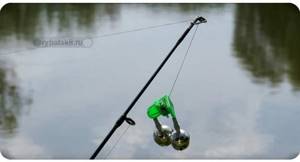
You can fix the bell on the rod using any household clamp. A more reliable option is to mount the device by combining a hook with wire/jute. The bite alarm should be installed 20 cm from the top of the fishing tool.
Using special devices to control the bait makes fishing more comfortable and productive. The trading network has different options for devices, including light, beepers, and electronic, which makes it easy to choose the best model for specific fishing conditions.
Fireflies
Firefly is an electronic feeder bite alarm designed for night fishing.
The design provides for a sealed capsule containing an LED and batteries. The alarm is attached to the fishing rod or bell.
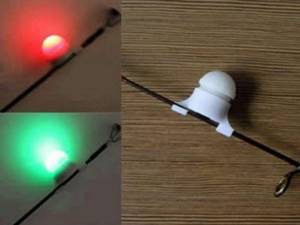
There are also fireflies based on the use of special liquids. This is a small plastic capsule containing 2 liquids.
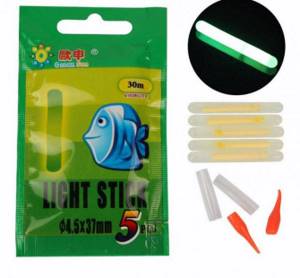
When a bite occurs, the liquids are mixed, as a result of which a chemical reaction begins, the device glows, indicating a bite.

